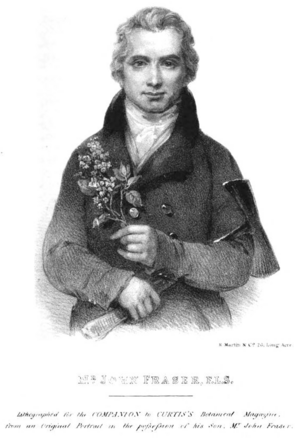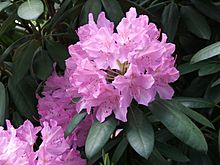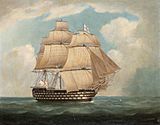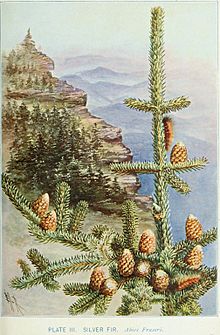John Fraser (botanist) facts for kids
Quick facts for kids
John Fraser
FLS, F.R.H.S.
|
|
|---|---|

John Fraser
(lithograph of an 18th-century portrait) |
|
| Born | 14 October 1750 |
| Died | 26 April 1811 (aged 60) |
| Occupation | Botanist and plant collector |
| Years active | 1780–1810 |
| Known for | Discovery and introduction of the flora of the Americas to Europe |
John Fraser (born October 14, 1750 – died April 26, 1811) was a Scottish botanist. He was a plant collector who traveled the world. From 1780 to 1810, he collected plants from North America, the West Indies, and Russia.
Fraser worked as a plant collector for important people. These included Catherine the Great, the Empress of Russia, in 1795. He also worked for Paul I of Russia in 1798 and the Dowager Empress Maria Feodorovna in 1806. He also ran a plant nursery and had a large collection of dried plants, called a herbarium. This collection was later sold to the Linnean Society of London.
Contents
Fraser's Early Life and Family
Growing Up in Scotland
John Fraser was born in Tomnacross, Scotland, on October 14, 1750. This was during a time called the Age of Enlightenment, when many new ideas were explored. His father was Donald Fraser, and his mother was Mary McLean.
John Fraser had two sons who followed in his footsteps. His oldest son, John Jr. (born around 1779), became a plant hunter and a respected nursery owner. He even met the famous American botanist Asa Gray. John Jr. later sold his father's plant collection to the Linnean Society. John Fraser's younger son, James Thomas, helped run the family plant nursery.
Moving to London
In 1770, when he was a young man, Fraser moved to London. He first worked as a hosier, selling linen. But he soon discovered the Chelsea Physic Garden. This garden inspired him to learn more about plants and help improve gardening in England. In 1778, he married Frances Shaw and settled in Chelsea.
Starting His Plant Adventures
John Fraser wasn't happy just working in London. He loved watching gardeners and soon became friends with William Forsyth, who managed the Apothecaries' Garden. Through this friendship, Fraser learned about earlier plant explorers like Mark Catesby, whose plant specimens were kept at the Chelsea Physic Garden.
Fraser decided to become a botanical collector himself. In 1780, he sailed to Newfoundland with Admiral Campbell. After returning to England, he sailed again in 1783 to explore the New World with his son, John Jr.
Important people helped fund Fraser's early trips. These included William Aiton from Kew Gardens and James Edward Smith from the Linnean Society. In the 1780s, Fraser opened the American Nursery in London. His sons continued to run this nursery after his death.
Exciting Journeys Around the World
In the late 1700s, plant hunters like John Fraser were true adventurers. They faced many dangers, including shipwrecks, pirates, and difficult travel conditions. Fraser traveled a lot, from Scotland to England, across the Americas, to the West Indies, and even to Russia.
He started collecting in Newfoundland from 1780 to 1784. Then he moved on to the Appalachian Mountains in eastern North America. He did all this without modern transportation like trains or good roads. By the end of his journeys, John Fraser had brought about 220 different plant species from the Americas to Europe.
Exploring the Appalachian Mountains
Fraser made his first trip to the American South in 1783 or 1784, specifically to Charleston, South Carolina. He sent many plants back home, but sadly, most of the valuable ones died. This led to some money problems and legal disputes for Fraser.
Despite these issues, he sailed back to South Carolina that autumn. He traveled north, befriending botanist Thomas Walter. He continued into the Piedmont region of the Appalachians. In Georgia, he discovered Phlox stolonifera, also known as Creeping Phlox.
In 1787, he found a plant near Chickamaua Cherokee land that later became known as Magnolia fraseri. He gave a sample of this plant to his friend, botanist William Bartram. Many new plants Fraser introduced were recorded in important gardening books of the time.
One of the most enterprising, indefatigable, and persevering men that ever embarked in the cause of botany and natural science.
In 1789, Fraser explored the Allegheny Mountains. He traveled with another botanist, François André Michaux. On the top of the Great Roan, Fraser was the first European to discover the Rhododendron catawbiense. This beautiful plant is now grown in many different varieties around the world. He wrote that the living plants he sent to England from this trip sold for a high price.
The Charleston Nursery

John's brother, James, helped with the plant business in America. They leased land in Charleston for their plant export-import business. They also bought land on Johns Island. However, they faced difficulties with their land deals and had some financial problems. Despite these challenges, they continued to ship many rhododendrons, magnolias, and other native plants from their Charleston nursery.
Adventures in Russia and a Shipwreck
In 1795, Fraser visited Saint Petersburg, Russia. He sold a special collection of plants to Empress Catherine the Great, who let him set his own price. While there, he bought Black and White Tartarian cherries and brought them to England for the first time.
In 1797, Czar Paul I ordered Fraser to be paid for his plants. By 1798, Fraser was given the important title of Botanical Collector to the Emperor Paul.
Trusting this important title, Fraser and his son John Jr. traveled again in 1799. They went to America and the West Indies. They even visited Thomas Jefferson at Monticello. They explored Kentucky, eastern Tennessee, and northern Georgia.
After returning to Charleston, they sailed for Cuba. This trip was very dangerous. Their ship was wrecked on a coral reef far from land. They barely escaped with their lives, enduring many hardships for six days before being rescued.
Collecting Plants in Cuba
While collecting plants in Cuba, Fraser met the famous explorers Alexander von Humboldt and Aimé Bonpland. This was a time when the seas were full of pirates. John's son returned to England first, carrying a large collection of plants from Humboldt.
Fraser returned to England in 1801 or 1802 with many rare plants. One of his discoveries was Jatropha pandurifolia. In 1807, both father and son sailed again to North America and the West Indies. On another trip from Cuba, Fraser brought back a tropical palm with silver leaves, Corypha miraguama. He tried to start a business making hats from its leaves, with support from the Queen, but it didn't work out.
Later Challenges and Journeys
When Fraser visited the Russian court again in 1805, hoping for payment, he was disappointed. The new Emperor, Alexander I, refused to recognize his old appointment. Fraser spent two years trying to get paid, finally getting help from the British ambassador. He was eventually paid by royal order in 1803. The Dowager Empress Maria Feodorovna, who loved botany, supported him. She gave him a diamond ring and asked him to collect plants for the Imperial Gardens.
After these difficulties, Fraser faced serious money problems. Even though he continued his plant research in America, his nursery back home suffered. His financial issues even led to a lawsuit with his brother James.
Fraser made his seventh and final trip to the United States in 1807. Near Charleston, he fell from his horse and broke several ribs. He never fully recovered from this injury. His last voyage before returning to England was to Cuba in 1810. Cuba had always welcomed him, and he had found many valuable plants there.
Fraser's Death
John Fraser was known as "John Fraser, the tireless" because of his hard work. However, his business troubles, travel difficulties, and injuries from his fall took a toll on him. He died in London in April 1811, at the age of 60. He left behind two sons.
Even after his death, his family faced financial burdens, as he was declared bankrupt. However, Fraser had made sure his will provided for his unmarried sister, Christy, who continued to receive support from his sons.
John Fraser's Lasting Impact
Throughout his travels, Fraser sent the plants he collected to his nursery in London. There, they were grown and sold to gardeners and architects. He also sent plants to his own plant collection, which later became part of the Linnean Society's collection. His clients included important figures like Catherine the Great, the Emperor Paul I, and the Dowager Empress Maria Feodorovna.
William Roscoe, a famous botanist, wrote that "John Fraser brought more plants into this kingdom [Britain] than any other person."
Even though Fraser died young, his sons continued his work. John Jr. went back to America and continued his own plant explorations before returning to England to start his own nursery. John Fraser is remembered as "one of the most enterprising, indefatigable, and persevering men that ever embarked in the cause of botany and natural science."
Plants Named After Fraser
Several plant species are named after John Fraser to honor his discoveries. These include:
- Abies fraseri (Fraser Fir): A type of fir tree. A 50-foot Fraser Fir was even used as the U.S. Capitol Christmas Tree in 1998.
- Magnolia fraseri (Fraser Magnolia): A beautiful flowering tree.
- Frasera: A group of plants in the gentian family.
- The Fraser's Saint John's wort (Triadenum fraseri).
Letters and Portraits
John Fraser's letters are kept at the Royal Society of Arts. One of his portraits hangs at the Hunt Library. Both Hoppner and Raeburn, famous painters, painted his portrait. Fraser was also a member of important groups like the Linnean Society of London and the Royal Horticultural Society.
See also
- History of botany
- List of gardener-botanist explorers of the Enlightenment
- Scottish Enlightenment
- The Plant List
- International Plant Names Index
- Botanical name
- History of plant systematics
- History of taxonomy





